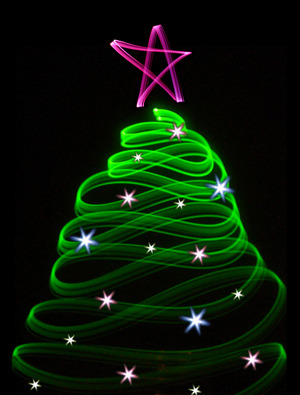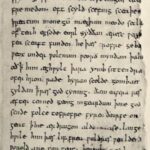Yule is the first day of winter and the longest day of the year. This day is celebrated as the death and birth of the Sun God – the Divine Child. The full moon after Yule is considered the most powerful of the whole year. It is the celebration of the death of the Holly king and the rebirth and renewed reign of the Oak king.
We celebrate Yule nearly exactly as you would Christmas. When the pagans of old were taken over by Christian rule, the Christians found it impossible to convert the pagans. They eventually allowed the pagan peoples to keep their holidays as long as they did them in the name of their Lord, Jesus Christ. This is why Christians celebrate the birth of their lord on this night, even though (even stated in the bible for those bible thumpers out there) Christ was born in the spring with the lambs. The Yule log, made of oak, is burned as sacrifice of the old dead Holly king. This day is a light festival, with as many lights on the tree and altar as possible to celebrate the coming of the new child. Mistletoe is hung because in the ancient days couples would play out their trial marriages on this day. ceremonies were held beneath Oak trees strung with garlands of mistletoe.
Yule is known to Pagans as the “Time of Great Darkness.” The nights grow long and the days grow short and the Sun before Yule seems to wither and die. Yule marks the coldest, darkest and harshest part of the year. Yule is always celebrated on the Winter Solstice. The Christian holiday Christmas was adapted from the ancient pagan tradition of celebrating the coming of the newborn Sun/Son to light the world. In the Pagan traditions he is born unto the Mother Goddess and in the Christian religions he is born to the Mother Mary.
The first written record for this holiday’s occurrence on December 25th was in 354 AD in Rome when one scholar wrote: ‘It was customary for Pagans to celebrate the birth of the Sun…when the doctors of the church perceived that the Christians had a leaning to this festival, they took counsel and resolved that the true Nativity should be solemnized on that day.'” (From “You Call it Christmas, We Call it Yule” by Peg Aloi – Witches’ Voice writer)
Pagans celebrate Yule by blessing their crop plants and animals. A common Yule practice is Wassailing. Apples from the fall harvest are made into a cider known as wassail. To ensure the fertility of their apple trees for the coming years, bits of cider-soaked bread were placed in the branches of the trees and libations of cider were poured over their roots. Later in history, guns were fired up through the branches to ward off evil spirits. In the same way, cider was often poured on livestock to ensure their fertility and good health for the next year.
Kissing under the mistletoe also stems from ancient Celtic traditions. The Winter Solstice was a time for marriage ceremonies. There was feasting and games and couples who wished to marry would come together at this time. Mistletoe was considered a very sacred plant and was thought to grow between the worlds symbolically because it grew on trees and not out of the ground. It was considered especially lucky when mistletoe grew on oaks because oaks have antibiotic properties which prevent fungi from growing on them. Mistletoe on oak was a symbol of harmony in unity and became an important symbol for marriage. Garlands of mistletoe were strung between trees and couples would dance or pass under the boughs and kiss, thus sealing their marriage for 1 year and 1 day. After this time if they no longer wished to be married, they could go their separate ways. This began the modern tradition of kissing under the mistletoe.
Holly is used in Yule decorations to symbolize the Holly King who dies at Yule to make way for the Oak King. The Yule log stems from this tradition. Some say that the log should be oak, some say ash and others say holly. Burning the Yule log symbolizes the sacrificial death of the Holly King and the reign of the Oak King over the second half of the year. The Yule log is decorated with paper decorations and plants such as holly, mistletoe, and evergreen sprigs. Red ribbons and tinsel are tied to the top of the log before it is burned in the fire. The Yule log must be lit on the first try and must remain burning for 12 hours for good luck. a piece of the log is saved to use to light the next year’s fire.
There are many ideas on where Christmas trees originally came from. Some say that the practice originated in ancient Egypt. Others say that it stems from ancient tree-worshiping practices. Today many Pagans refuse to cut down trees and use fake trees instead. Those who still cut down trees every year say that you must cut your own instead of buying one and afterward, the tree should be burned.
During this night, the longest night of the year, Pagans light as many candles as can be found both to symbolically wait out the death of the Lord and to celebrate the coming of new light. At no other time of the year is light more sacred. Many believe that it is taboo to extinguish any flame or to travel at Yuletide.
Feasting has always been a Yule tradition. These meals celebrate the harvest that was gathered in the autumn and to celebrate the passing of winter. It is the time when the days begin to grow longer as the Lord grows stronger and climbs further and further up the sky. Tables, altars, and Yule trees are covered in lights and candles. As many lights as possible lie strewn about in anticipation of the birth of the new child Sun King from the womb of the Mother.
For more information on Pagan holidays, check out www.witch-crafted.com.





